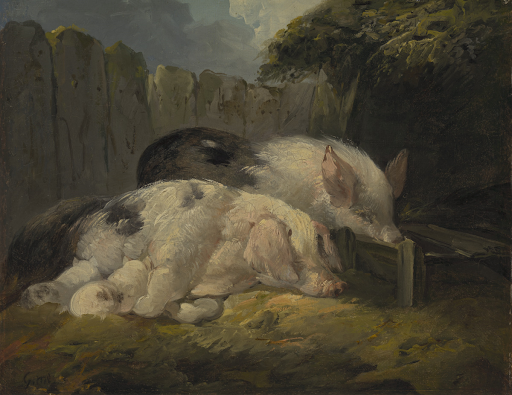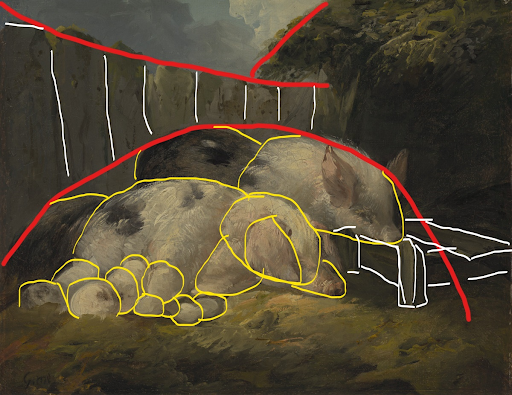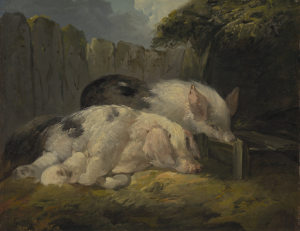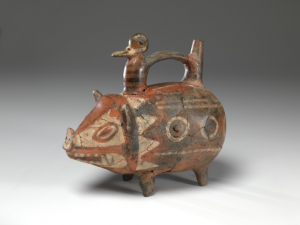Art History
What this handout is about
This handout discusses a few common assignments found in art history courses. To help you better understand those assignments, this handout highlights key strategies for approaching and analyzing visual materials.
Writing in art history
Evaluating and writing about visual material uses many of the same analytical skills that you have learned from other fields, such as history or literature. In art history, however, you will be asked to gather your evidence from close observations of objects or images. Beyond painting, photography, and sculpture, you may be asked to write about posters, illustrations, coins, and other materials.
Even though art historians study a wide range of materials, there are a few prevalent assignments that show up throughout the field. Some of these assignments (and the writing strategies used to tackle them) are also used in other disciplines. In fact, you may use some of the approaches below to write about visual sources in classics, anthropology, and religious studies, to name a few examples.
This handout describes three basic assignment types and explains how you might approach writing for your art history class.Your assignment prompt can often be an important step in understanding your course’s approach to visual materials and meeting its specific expectations. Start by reading the prompt carefully, and see our handout on understanding assignments for some tips and tricks.
Three types of assignments are discussed below:
- Visual analysis essays
- Comparison essays
- Research papers
1. Visual analysis essays
Visual analysis essays often consist of two components. First, they include a thorough description of the selected object or image based on your observations. This description will serve as your “evidence” moving forward. Second, they include an interpretation or argument that is built on and defended by this visual evidence.
Formal analysis is one of the primary ways to develop your observations. Performing a formal analysis requires describing the “formal” qualities of the object or image that you are describing (“formal” here means “related to the form of the image,” not “fancy” or “please, wear a tuxedo”). Formal elements include everything from the overall composition to the use of line, color, and shape. This process often involves careful observations and critical questions about what you see.
Pre-writing: observations and note-taking
To assist you in this process, the chart below categorizes some of the most common formal elements. It also provides a few questions to get you thinking.
Composition
|
Technique
|
Color
|
Texture
|
Line
|
Scale
|
Material
|
Shape
|
Let’s try this out with an example. You’ve been asked to write a formal analysis of the painting, George Morland’s Pigs and Piglets in a Sty, ca. 1800 (created in Britain and now in the Virginia Museum of Fine Arts in Richmond).

What do you notice when you see this image? First, you might observe that this is a painting. Next, you might ask yourself some of the following questions: what kind of paint was used, and what was it painted on? How has the artist applied the paint? What does the scene depict, and what kinds of figures (an art-historical term that generally refers to humans) or animals are present? What makes these animals similar or different? How are they arranged? What colors are used in this painting? Are there any colors that pop out or contrast with the others? What might the artist have been trying to accomplish by adding certain details?
What other questions come to mind while examining this work? What kinds of topics come up in class when you discuss paintings like this one? Consider using your class experiences as a model for your own description! This process can be lengthy, so expect to spend some time observing the artwork and brainstorming.
Here is an example of some of the notes one might take while viewing Morland’s Pigs and Piglets in a Sty:
Composition
- The animals, four pigs total, form a gently sloping mound in the center of the painting.
- The upward mound of animals contrasts with the downward curve of the wooden fence.
- The gentle light, coming from the upper-left corner, emphasizes the animals in the center. The rest of the scene is more dimly lit.
- The composition is asymmetrical but balanced. The fence is balanced by the bush on the right side of the painting, and the sow with piglets is balanced by the pig whose head rests in the trough.
Color
- Throughout the composition, the colors are generally muted and rather limited. Yellows, greens, and pinks dominate the foreground, with dull browns and blues in the background.
- Cool colors appear in the background, and warm colors appear in the foreground, which makes the foreground more prominent.
- Large areas of white with occasional touches of soft pink focus attention on the pigs.
Technique
- The paint is applied very loosely, meaning the brushstrokes don’t describe objects with exact details but instead suggest them with broad gestures.
- The ground has few details and appears almost abstract.
- The piglets emerge from a series of broad, almost indistinct, circular strokes.
Shape
- The painting contrasts angular lines and rectangles (some vertical, some diagonal) with the circular forms of the pig.
- The negative space created from the intersection of the fence and the bush forms a wide, inverted triangle that points downward. The point directs viewers’ attention back to the pigs.
Because these observations can be difficult to notice by simply looking at a painting, art history instructors sometimes encourage students to sketch the work that they’re describing. The image below shows how a sketch can reveal important details about the composition and shapes.

Marked-up version includes the following: large compositional elements in red, circular shapes in yellow, and rectangular shapes and vertical lines in white.
Writing: developing an interpretation
Once you have your descriptive information ready, you can begin to think critically about what the information in your notes might imply. What are the effects of the formal elements? How do these elements influence your interpretation of the object?
Your interpretation does not need to be earth-shatteringly innovative, but it should put forward an argument with which someone else could reasonably disagree. In other words, you should work on developing a strong analytical thesis about the meaning, significance, or effect of the visual material that you’ve described. For more help in crafting a strong argument, see our Thesis Statements handout.
For example, based on the notes above, you might draft the following thesis statement:
In Morland’s Pigs and Piglets in a Sty, the close proximity of the pigs to each other–evident in the way Morland has overlapped the pigs’ bodies and grouped them together into a gently sloping mound–and the soft atmosphere that surrounds them hints at the tranquility of their humble farm lives.
Or, you could make an argument about one specific formal element:
In Morland’s Pigs and Piglets in a Sty, the sharp contrast between rectilinear, often vertical, shapes and circular masses focuses viewers’ attention on the pigs, who seem undisturbed by their enclosure.
Support your claims
Your thesis statement should be defended by directly referencing the formal elements of the artwork. Try writing with enough specificity that someone who has not seen the work could imagine what it looks like. If you are struggling to find a certain term, try using this online art dictionary: Tate’s Glossary of Art Terms.
Your body paragraphs should explain how the elements work together to create an overall effect. Avoid listing the elements. Instead, explain how they support your analysis.
As an example, the following body paragraph illustrates this process using Morland’s painting:
Morland achieves tranquility not only by grouping animals closely but also by using light and shadow carefully. Light streams into the foreground through an overcast sky, in effect dappling the pigs and the greenery that encircles them while cloaking much of the surrounding scene. Diffuse and soft, the light creates gentle gradations of tone across pigs’ bodies rather than sharp contrasts of highlights and shadows. By modulating the light in such subtle ways, Morland evokes a quiet, even contemplative mood that matches the restful faces of the napping pigs.
This example paragraph follows the 5-step process outlined in our handout on paragraphs. The paragraph begins by stating the main idea, in this case that the artist creates a tranquil scene through the use of light and shadow. The following two sentences provide evidence for that idea. Because art historians value sophisticated descriptions, these sentences include evocative verbs (e.g., “streams,” “dappling,” “encircles”) and adjectives (e.g., “overcast,” “diffuse,” “sharp”) to create a mental picture of the artwork in readers’ minds. The last sentence ties these observations together to make a larger point about the relationship between formal elements and subject matter.
There are usually different arguments that you could make by looking at the same image. You might even find a way to combine these statements!
Remember, however you interpret the visual material (for example, that the shapes draw viewers’ attention to the pigs), the interpretation needs to be logically supported by an observation (the contrast between rectangular and circular shapes). Once you have an argument, consider the significance of these statements. Why does it matter if this painting hints at the tranquility of farm life? Why might the artist have tried to achieve this effect? Briefly discussing why these arguments matter in your thesis can help readers understand the overall significance of your claims. This step may even lead you to delve deeper into recurring themes or topics from class.
Tread lightly
Avoid generalizing about art as a whole, and be cautious about making claims that sound like universal truths. If you find yourself about to say something like “across cultures, blue symbolizes despair,” pause to consider the statement. Would all people, everywhere, from the beginning of human history to the present agree? How do you know? If you find yourself stating that “art has meaning,” consider how you could explain what you see as the specific meaning of the artwork.
Double-check your prompt. Do you need secondary sources to write your paper? Most visual analysis essays in art history will not require secondary sources to write the paper. Rely instead on your close observation of the image or object to inform your analysis and use your knowledge from class to support your argument. Are you being asked to use the same methods to analyze objects as you would for paintings? Be sure to follow the approaches discussed in class.
Some classes may use “description,” “formal analysis” and “visual analysis” as synonyms, but others will not. Typically, a visual analysis essay may ask you to consider how form relates to the social, economic, or political context in which these visual materials were made or exhibited, whereas a formal analysis essay may ask you to make an argument solely about form itself. If your prompt does ask you to consider contextual aspects, and you don’t feel like you can address them based on knowledge from the course, consider reading the section on research papers for further guidance.
2. Comparison essays
Comparison essays often require you to follow the same general process outlined in the preceding sections. The primary difference, of course, is that they ask you to deal with more than one visual source. These assignments usually focus on how the formal elements of two artworks compare and contrast with each other. Resist the urge to turn the essay into a list of similarities and differences.
Comparison essays differ in another important way. Because they typically ask you to connect the visual materials in some way or to explain the significance of the comparison itself, they may require that you comment on the context in which the art was created or displayed.
For example, you might have been asked to write a comparative analysis of the painting discussed in the previous section, George Morland’s Pigs and Piglets in a Sty (ca. 1800), and an unknown Vicús artist’s Bottle in the Form of a Pig (ca. 200 BCE–600 CE). Both works are illustrated below.


Pre-writing: observations and note-taking
You can begin this kind of essay with the same process of observations and note-taking outlined above for formal analysis essays. Consider using the same questions and categories to get yourself started.
Here are some questions you might ask:
- What techniques were used to create these objects?
- How does the use of color in these two works compare? Is it similar or different?
- What can you say about the composition of the sculpture? How does the artist treat certain formal elements, for example geometry? How do these elements compare to and contrast with those found in the painting?
- How do these works represent their subjects? Are they naturalistic or abstract? How do these artists create these effects?
Why do these similarities and differences matter?
As our handout on comparing and contrasting suggests, you can organize these thoughts into a Venn diagram or a chart to help keep the answers to these questions distinct.
For example, some notes on these two artworks have been organized into a chart:
| Pigs and Piglets in a Sty | Both Art Works | Bottle in the Form of a Pig | |
|---|---|---|---|
| Topic | Both depict a pig-like animal | ||
| Number | Focus is on two pigs and two piglets (4 animals total) | Focus is on one pig-like animal that makes up the majority of the vessel; vessel’s spout resembles a bird | |
| Colors | White and pink colors on the animals contrast with browns and blues in background | Both use contrasting colors to focus the viewer’s eye | Borders and other elements are defined by black and cream slip to highlight specific anatomical features |
| Setting | Trees, clouds, and wooden fence in background; animals and trough in foreground | No setting beyond the vessel itself | |
| Shape | Rectilinear, vertical shapes of trees and fence contrast with circular, more horizontal shapes of animals | Both use shape to link individual components to the whole composition | Composed of geometric shapes: the body is formed by a round cylinder; ears are concave pyramids, etc. |
As you determine points of comparison, think about the themes that you have discussed in class. You might consider whether the artworks display similar topics or themes. If both artworks include the same subject matter, for example, how does that similarity contribute to the significance of the comparison? How do these artworks relate to the periods or cultures in which they were produced, and what do those relationships suggest about the comparison? The answers to these questions can typically be informed by your knowledge from class lectures. How have your instructors framed the introduction of individual works in class? What aspects of society or culture have they emphasized to explain why specific formal elements were included or excluded? Once you answer your questions, you might notice that some observations are more important than others.
Writing: developing an interpretation that considers both sources
When drafting your thesis, go beyond simply stating your topic. A statement that says “these representations of pig-like animals have some similarities and differences” doesn’t tell your reader what you will argue in your essay.
To say more, based on the notes in the chart above, you might write the following thesis statement:
Although both artworks depict pig-like animals, they rely on different methods of representing the natural world.
Now you have a place to start. Next, you can say more about your analysis. Ask yourself: “so what?” Why does it matter that these two artworks depict pig-like animals? You might want to return to your class notes at this point. Why did your instructor have you analyze these two works in particular? How does the comparison relate to what you have already discussed in class? Remember, comparison essays will typically ask you to think beyond formal analysis.
While the comparison of a similar subject matter (pig-like animals) may influence your initial argument, you may find that other points of comparison (e.g., the context in which the objects were displayed) allow you to more fully address the matter of significance. Thinking about the comparison in this way, you can write a more complex thesis that answers the “so what?” question. If your class has discussed how artists use animals to comment on their social context, for example, you might explore the symbolic importance of these pig-like animals in nineteenth-century British culture and in first-millenium Vicús culture. What political, social, or religious meanings could these objects have generated? If you find yourself needing to do outside research, look over the final section on research papers below!
Supporting paragraphs
The rest of your comparison essay should address the points raised in your thesis in an organized manner. While you could try several approaches, the two most common organizational tactics are discussing the material “subject-by-subject” and “point-by-point.”
- Subject-by-subject: Organizing the body of the paper in this way involves writing everything that you want to say about Moreland’s painting first (in a series of paragraphs) before moving on to everything about the ceramic bottle (in a series of paragraphs). Using our example, after the introduction, you could include a paragraph that discusses the positioning of the animals in Moreland’s painting, another paragraph that describes the depiction of the pigs’ surroundings, and a third explaining the role of geometry in forming the animals. You would then follow this discussion with paragraphs focused on the same topics, in the same order, for the ancient South American vessel. You could then follow this discussion with a paragraph that synthesizes all of the information and explores the significance of the comparison.
- Point-by-point: This strategy, in contrast, involves discussing a single point of comparison or contrast for both objects at the same time. For example, in a single paragraph, you could examine the use of color in both of our examples. Your next paragraph could move on to the differences in the figures’ setting or background (or lack thereof).
Tread lightly
As our use of “pig-like” in this section indicates, titles can be misleading. Many titles are assigned by curators and collectors, in some cases years after the object was produced. While the ceramic vessel is titled Bottle in the Form of a Pig, the date and location suggest it may depict a peccary, a pig-like species indigenous to Peru. As you gather information about your objects, think critically about things like titles and dates. Who assigned the title of the work? If it was someone other than the artist, why might they have given it that title? Don’t always take information like titles and dates at face value.
Be cautious about considering contextual elements not immediately apparent from viewing the objects themselves unless you are explicitly asked to do so (try referring back to the prompt or assignment description; it will often describe the expectation of outside research). You may be able to note that the artworks were created during different periods, in different places, with different functions. Even so, avoid making broad assumptions based on those observations. While commenting on these topics may only require some inference or notes from class, if your argument demands a large amount of outside research, you may be writing a different kind of paper. If so, check out the next section!
3. Research papers
Some assignments in art history ask you to do outside research (i.e., beyond both formal analysis and lecture materials). These writing assignments may ask you to contextualize the visual materials that you are discussing, or they may ask you to explore your material through certain theoretical approaches. More specifically, you may be asked to look at the object’s relationship to ideas about identity, politics, culture, and artistic production during the period in which the work was made or displayed. All of these factors require you to synthesize scholars’ arguments about the materials that you are analyzing. In many cases, you may find little to no research on your specific object. When facing this situation, consider how you can apply scholars’ insights about related materials and the period broadly to your object to form an argument. While we cannot cover all the possibilities here, we’ll highlight a few factors that your instructor may task you with investigating.
Iconography
Papers that ask you to consider iconography may require research on the symbolic role or significance of particular symbols (gestures, objects, etc.). For example, you may need to do some research to understand how pig-like animals are typically represented by the cultural group that made this bottle, the Vicús culture. For the same paper, you would likely research other symbols, notably the bird that forms part of the bottle’s handle, to understand how they relate to one another. This process may involve figuring out how these elements are presented in other artworks and what they mean more broadly.
Artistic style and stylistic period
You may also be asked to compare your object or painting to a particular stylistic category. To determine the typical traits of a style, you may need to hit the library. For example, which period style or stylistic trend does Moreland’s Pigs and Piglets in a Sty belong to? How well does the piece “fit” that particular style? Especially for works that depict the same or similar topics, how might their different styles affect your interpretation? Assignments that ask you to consider style as a factor may require that you do some research on larger historical or cultural trends that influenced the development of a particular style.
Provenance
Provenance research asks you to find out about the “life” of the object itself. This research can include the circumstances surrounding the work’s production and its later ownership. For the two works discussed in this handout, you might research where these objects were originally displayed and how they ended up in the museum collections in which they now reside. What kind of argument could you develop with this information? For example, you might begin by considering that many bottles and jars resembling the Bottle in the Form of a Pig can be found in various collections of Pre-Columbian art around the world. Where do these objects originate? Do they come from the same community or region?
Patronage study
Prompts that ask you to discuss patronage might ask you to think about how, when, where, and why the patron (the person who commissions or buys the artwork or who supports the artist) acquired the object from the artist. The assignment may ask you to comment on the artist-patron relationship, how the work fit into a broader series of commissions, and why patrons chose particular artists or even particular subjects.
Additional resources
To look up recent articles, ask your librarian about the Art Index, RILA, BHA, and Avery Index. Check out www.lib.unc.edu/art/index.html for further information!
Works consulted
We consulted these works while writing this handout. This is not a comprehensive list of resources on the handout’s topic, and we encourage you to do your own research to find additional publications. Please do not use this list as a model for the format of your own reference list, as it may not match the citation style you are using. For guidance on formatting citations, please see the UNC Libraries citation tutorial. We revise these tips periodically and welcome feedback.
Adams, Laurie Schneider. 2003. Looking at Art. Upper Saddle River, NJ: Prentice Hall.
Barnet, Sylvan. 2015. A Short Guide to Writing about Art, 11th ed. Upper Saddle River, NJ: Prentice Hall.
Tate Galleries. n.d. “Art Terms.” Accessed November 1, 2020. https://www.tate.org.uk/art/art-terms.
This work is licensed under CC BY-NC-ND 4.0
You may reproduce it for non-commercial use if you use the entire handout and attribute the source: The Writing Center, University of North Carolina at Chapel Hill
